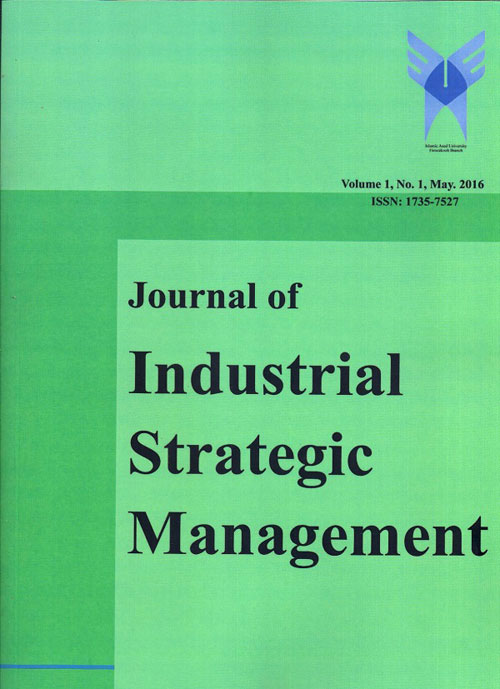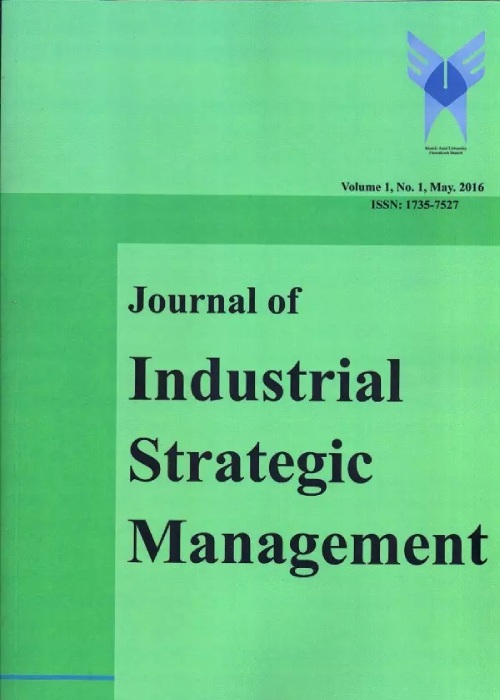فهرست مطالب

Journal of Industrial Strategic Management
Volume:4 Issue: 2, Summer-Autumn 2019
- تاریخ انتشار: 1399/06/17
- تعداد عناوین: 6
-
Pages 1-11The purpose of this paper is to apply TRIZ for solving the GSC problems in Sobhanoncology pharmaceutical firm. A review of the past papers of TRIZ based methods to GSC problem resolution is presented. The TRIZ contradiction matrix tool which was applied to the specific problem brings many benefits e.g.: being rapid acceleration in solving the problem. Moreover provides repeatability, reliability and also cut costs and times due to its structure. The situation is based on a manufacturing process problem. To recognize, understand, analyze, and solve the problem, the author identifies six steps which are applying Fish bone diagram, illustrating non-existence of optimization, showing the contradiction by classical TRIZ system of contradiction model, Linking the Contradiction, decision and evaluation space, and applying TRIZ contradiction matrix to solve the problem. According to the result of distributive questionnaire the problem is related to ineffective pressing process of one of tablets which is named Flutamid. According to the problem which is technical and has technical contradiction, TRIZ contradiction matrix is chosen. according to comparison of profit and loss, following the principle 35, by changing physical state in process condition could be made to resolve problem. Instead of granule powder, the liquid one can be applied which will be formed in low temperature to solid one. As a result, no wasting time could be happened. To this end, although TRIZ contradiction matrix provides 39 general parameters to solve technical contradiction (Karimi, 2007), none offers a specific framework which includes details for each parameters.Keywords: Theory of inventive problem solving (TRIZ), Green Supply Chain (GSC), Optimization, contradiction
-
Pages 12-22It is obvious that the success of a project-based organization is dependent on its projects. A variety of tools such as the project excellence model, project management maturity models, the earned value method, have been developed in this regard, but there are still delays in projects because the projects have dynamic nature with non-linear relationships and feedback processes during the project life cycle. In this paper, we study the factors affecting the project management system in a project-based organization through system dynamics methodology and investigate the causal relations between them as well as the average cost and time variation of organizational projects during the time period. According to the analyses, the increase in each of the project quality or human resource efficiency is insufficient by raising the level of project management maturity or leadership maturity, but their concurrent increase and created synergy have a significant impact on the cost and time variation control. Furthermore, this research is contrary to the public perceptions under which the progress of projects depends on their funding. It is probably due to the maturity level of project management and the maturity of its leadership who takes measures for better management of costs and delaysKeywords: Project-Based Organization, Project Management, Systems Dynamics, Project Management Maturity Model
-
Pages 23-32There has been a lot of problems for Universities that the main problems of the students are obliged to pay high fees for education and also inability of university to provide appropriate services in terms of quality and quantity of the students. These two factors cause psychological and even physical problems in the country's students an after a while their motivation for continuing education greatly get lowers. One of the most important part of the problems mentioned there, are self-services of Universities that in addition to their high cost, provide poor quality of their service level. In this article, we check the one of the self-services of country's Universities and we plan to implement a Sustainable Supply Chain in this section to minimize the costs and the quality of the food served in this sector to reach its maximum to reach the economically optimal point and raise the level of customer satisfaction to at least provide their needs and avoid the creation of adverse effects. We examined a four-level chain that made from distributor, logistics, self-service and customer. We want to use a multi-objective function, dual economic objective (cost) and social (quality) to deliver efficient point and also putting information at each level of the chain to the other levels, to minimize bullwhip effect on the entire supply chain and amount of inventory at each of the levels and therefore reduce total costs in this area and to increase the quantity and quality of cooking.Keywords: Supply chain network design, Sustainability, self-service, linear programming
-
Pages 33-50
This study aimed to determine the relation between quantum management skills and organizational agility capabilities with the mediating role of organizational intelligence. The method of research was a descriptive and correlational based on Structural Equation Modeling (SEM), and the statistical population consisting of all administrators from state universities of Isfahan in academic year 2015. 151 persons were selected by classical random sampling. Three questionnaires were used for collecting data: Quantum management skills, Organizational agility capabilities and Organizational intelligence. Their reliability was computed by Cronbach's alpha coefficients and it was r = 0.97, 0.93, 0.92, respectively. Therefore, their contents validity and construction were confirmed. Statistical SPSS 23, amos23, and EQS were used for data analysis. Findings showed that quantum management skills were affected with path coefficient (r=.33) on organizational agility capabilities with path coefficient (r=.41) on organizational intelligence and organizational intelligence with a path coefficient of (r=.78) on organizational agility capabilities and organizational intelligence mediates relation between Quantum management skills and organizational agility capabilities of the selected university managers.
Keywords: quantum management, Organizational Agility, organizational intelligence, university managers (administrators) -
Pages 51-66
The destination of tourism is a major element in tourism marketing. Branding tourism destination is a process by which a tourism destination develops its focal features, develops and delivers its main audience, can build a reputation, establish its reputation, strengthen slowly or even change, which is important for tourism purposes. Brand recognition is very important for communicating successfully between tourists and the destinations they are visiting. In this research, we tried to use a systematic review of internal and external databases for compilation of articles. Of the 366 papers found, 40 papers were finally included. Finally, after extracting the components related to branding objectives, these components were weighed and prioritized by the experts and with the logarithmic fuzzy preferences programming approach (LFPP). The output of the research is that brand personality and image, brand commitment and trust, market communication and audit, and destination components are more important and have been prioritized for branding tourism destinations.
Keywords: Tourism Destination Brand, Meta synthesis, LFPP Approach -
Pages 67-80
The present study aimed to determine the effect of risk management on supply chain management(case study: Saipa Company). This study was applied in terms of purpose and descriptive-correlational in terms of data collection method. The tools used in this study include the 29-item questionnaire. The statistical population of this study included 110 managers of Saipa Company in Tehran. In this study, 86 samples were required using the Morgan Table. In general, 100 questionnaires were distributed and 89 questionnaires were completely returned to the researcher. In order to determine the sample size, the Morgan Table was used. Thus, 100 questionnaires were distributed and a number of 89 complete questionnaires were entered the analysis after eliminating the unfilled and unreadable questionnaires. The software used for descriptive statistics included SPSS and PLS for confirmatory factor analysis using the structural equations technique (SEM). The research findings indicated that all research hypotheses, except behavioral uncertainty, other factors such as risk reduction, environmental uncertainty, risk management process, and risk monitoring affect the performance of supply chain.
Keywords: Risk, risk management, supply chain management


